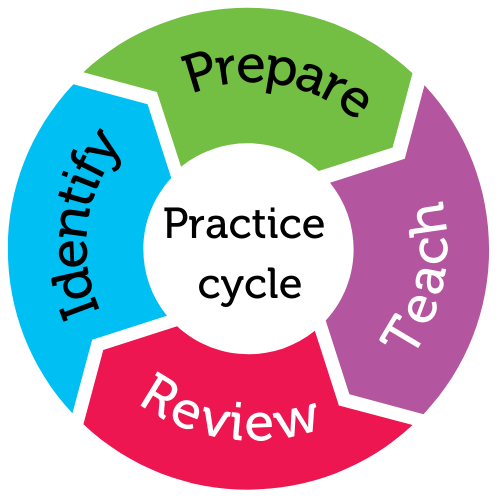
For student year
Helps students to
- manage transitions
- be less anxious
Helps teachers to
- transition students
- communicate change
Summary
Most students, including those on the autism spectrum, thrive in structured and logical learning environments. You can provide structure and predictability by carefully preparing students for transitioning between;
- activities
- learning spaces and
- environments.
Transition between activities, learning spaces, and indoor and outdoor environments may require students to stop doing something they like, which can be difficult. Alerting students to the impending change can make the transition easier. Students use communication, self-regulation, and social skills during transitions, and this should be taken into consideration when planning transitions.
By developing, teaching, and consistently using transition routines, you can:
- support students in your class to understand what is happening
- reduce anxiety related to unexpected transitions and
- reduce behavioural concerns.
How this practice works
Watch this video to learn more about transitions.
(Duration 2:40)
Australian Professional Standards for Teachers related to this practice
3.5 - Use effective classroom communication
4.2 - Manage classroom activities
For further information, see Australian Professional Standards for Teachers AITSL page
Preparing to teach
What is a transition?
A transition is the movement from one activity, learning space, or environment to another. Transition routines are an established series of steps that guide students through a transition. Some students may have difficulty with transitions.
Use these steps to help you prepare your transition plan:
- Review your daily classroom routine to identify regular transitions that occur throughout the day. For example, this can be from morning tea to the classroom, from literacy to maths, or from the classroom to the field for P.E.
- Design a transition routine appropriate for these transitions.
- Establish a series of steps associated with the completion of that movement. For example, you can provide a 5-minute and then a 3-minute warning with reference to supporting visual routine prompts before students needs to switch tasks. You can use countdown timers for the whole class or some students may need personal countdown timers on their desks.
- Produce visual supports to show the transition steps (a picture of the example would be ideal).
- Prepare/create supporting materials (photos of other examples would be good e.g., a ‘no’ symbol to place over a part of the routine which may not be happening).
- Ensure that supporting materials are ready and in place for students.
Remember to take into account the type of activity and the student's reaction to it:
- A favoured activity will make a transition away harder, especially if the transition from has not been communicated effectively. An example could be a student who prefers to finish a writing task and becomes frustrated when they haven't been able to finish before being transitioned to the next activity.
- A less desired activity will make the transition to the activity harder, which may result in anxiety around the task. An example could be a student who feels less confident at maths who may become restless when this activity occurs.
Easing students into transition routines can reduce these behavioural concerns.
It works better if you:
- use visual supports to support the transition routine
- use the same initial steps in as many of the transition routines as possible, e.g., books away, stand up, chair in, wait
- positively reinforce students for following the transition routine
It doesn’t work if you:
- don't use the transition routine consistently
- constantly change the routine, or change the routine without warning
In the classroom
Steps to applying a transition routine
- Ensure supporting materials are ready and in place for students.
- Clearly and explicitly explain the transition to your students, e.g., "In 5 minutes we are going to stop the activity and move onto the next section, please check the countdown timer to see how much time is left."
- Consistently use these transition routines and any associated visual supports.
- Prepare students for changes in their transition routine as early as possible and ahead of time.
- Prepare students as early as possible for new, one-off, or unexpected transitions.
Help students to know what to expect
- Talk through what is going to happen in the transition – with individual students and/or the class.
- Walk through the transition beforehand.
- Use visual supports to help students follow a transition routine.
If a familiar transition routine has to change, use visual supports to forewarn students such as flexible/impromptu symbols or cue cards. For example, a ‘no’ symbol can be placed over a step to show that it will not be occurring.
How will I know if it's working?
- Occurrences of off-task behaviours during transitions decrease
- Students can transition independently
- Anxiety around transitioning decreases
Practice toolkit
Practice implementation planner template
We know it's not always easy to keep track of what's working and what isn't. So, we've created this template for you to record and reflect on what you're doing to create more inclusive classrooms. The implementation planner contains:
- guidance around goal setting
- a reflection section (what worked, didn’t work, what to change, and next steps)
- prompting questions.
Implementation planner with examples
Set your professional learning goal for:
Prepare students for transitions
Benefits of goal setting
Setting, working towards, and reflecting on goals helps you grow professionally and improve your practice. You can access AITSL learning resources for teachers to learn more about:How to set goals
The Australian Institute for Teaching and School Leadership recommends using the SMART matrix to frame your goal setting.SMART goals refers to goals that are:
- Specific
- Measurable
- Achievable
- Relevant
- Time-phased
Resources
Prepare students for transitions - Practice Brief
Related Practices

Use visual schedules
TEACHING PRACTICE
For student years
Helps students to
- transition smoothly
- understand expectations
- learn new concepts
This practice is from the core research project
Learning Cycle

